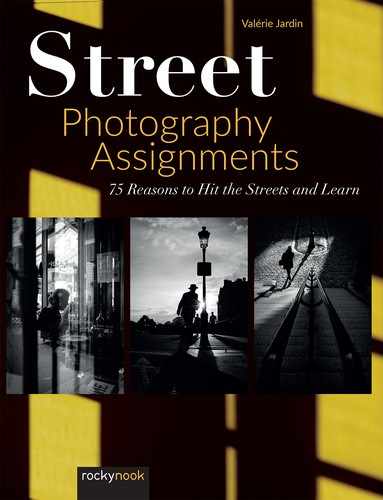ASSIGNMENT 8
Silhouettes
ASSIGNMENT
The moment you see light, your camera becomes a magic wand. For this assignment, your mission is to capture an amazing silhouette. The technical part of the silhouette is the easy part. To make a successful silhouette, though, you have to be extremely discerning in the choice of location and subject.
TECHNIQUE
The success of the image depends on the photographer’s ability to make quick decisions and even faster adjustments. It is important to know your camera dials well and use shortcuts when necessary. Focusing can be difficult. You can spot meter for the highlights and manually focus on your subject. Or, if you shoot in aperture priority mode, set your camera to a small aperture to allow for a large depth of field, and most of the scene will be in focus (f/5.6 for a crop sensor camera or f/8 for a full frame should do the trick). Ideally your camera will be in spot metering mode so that you meter on the highlights. I tend to keep my camera on average or matrix metering and turn the exposure compensation dial down by 1/3-stop increments as necessary because it is much faster than switching to spot metering in the moment when I see a silhouette situation.
I’m also not against blowing out the highlights. Blown highlights have two advantages: They remove distractions behind your subject and give your photograph a more dramatic effect. Photographing from a low angle will give you the best chances on the streets because your subject will stand out against the bright sky and not disappear against the dark background of the streets.
Now that you know the basic technique to shoot the silhouette, the most important piece of the equation is to be able to seek potentially strong subjects. Visually separating body parts is important; you should be able to recognize the shape right away. It is easier to photograph a single subject than a group. If there are several people involved, it is important to have separation between them and minimal overlap. If the subject is facing you or their back is turned to you, there should be space between the arms and the body, and the legs should be in a graceful position. If you’re photographing a person looking sideways, it is best if the facial features are defined. Small details will make a really big difference in the success of the photograph.
TIP
It is important to note that obstructions behind silhouettes are just as distracting as anything placed in front of the subject. You would not photograph a subject standing behind a post, would you? Remember that in a silhouette, the post will get just as much in the way if it is behind the subject.
In the Window Light / Minneapolis, 2020
Facial features should be visible when photographing a subject from the side.
Fujifilm X100F, 23mm, f/5.6, 1/750 sec., ISO 200
Now Boarding / CDG, Paris, 2014
Avoid distraction in front of and behind the subject!
Fujifilm X-T1, 50mm, f/4.5, 1/2500 sec., ISO 200
Fun on the Ramp / Paris, 2013
Multiple subjects should not overlap.
Fujifilm X100S, 23mm, f/4, 1/2000 sec., ISO 200



